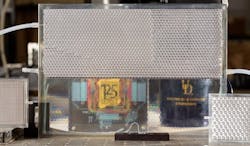Liquid-filled smart glass is cheaper, better than competing designs
Keith Goossen, associate professor of electrical and computer engineering at the University of Delaware (UD; Newark, DE) and Daniel Wolfe, who earned a doctoral degree from UD last year, developed panels that can switch between allowing light in and blocking it out. This eco-friendly "smart glass" technology could be utilized in eco-friendly windows, windshields, roof panes, and building envelopes, absorbing light and heat in the winter and reflecting it away in the summer.
RELATED ARTICLE: NREL switchable solar window uses perovskites and CNTs
Although Goossen isn't the first scientist to make smart glass, his team's invention is about one-tenth the price of other versions. It is also more transparent in its transparent state and more reflective in its reflective state than competitors, he said.
Goossen shared his latest smart glass prototype on Monday, March 5 in a keynote address at the SPIE Smart Materials and Nondestructive Evaluation for Energy Systems IV conference in Denver. The principles behind this smart glass technology are surprisingly simple. It starts with two sheets of plastic separated by a thin cavity. The plastic contains tiny cube-shaped structures that make the material retroreflective, meaning that it bounces light back to its source, like a bicycle reflector does.
Then the chamber is filled with a fluid called methyl salicylate--an inexpensive wintergreen extract that happens to be the active ingredient in some over-the-counter pain relief creams. This liquid has optical properties, or interaction with visible light, that match the optical properties of the retroreflective plastic. When combined, the light can pass through, and the system becomes transparent due to refractive index matching.
Goossen's smart glass system can switch from transparent to reflective a thousand times without degrading. A new, improved design relies on the total internal reflection of one-dimensional structures layered perpendicularly rather than the original cube structure. It is highly reflective at up to a 60-degree angle of incidence, an improvement over the previous prototype.
Goossen uses 3D printing to make his prototypes, but this technology could eventually be manufactured at a high volume and low cost using injection molding. He is now testing his system over a wide range of temperatures to see how it performs, especially as it approaches temperatures that could cause the fluid within to freeze, which will be between 3 and 16 degrees Fahrenheit, depending upon the eventual fluid that is used. Every time Goossen talks to a roomful of engineers about this project, hands go up with lots of questions.
Commercialization may eventually follow--something Goossen is already well versed in. An author of 82 issued patents, he founded a startup company in 2001 that was later acquired. He passes his knowledge along to students as a co-teacher of High Technology Entrepreneurship, a course for undergraduate and graduate students that focuses on financial, legal, scientific, and engineering issues facing tech startups.
SOURCE: University of Delaware; http://www.udel.edu/udaily/2018/march/keith-goossen-smart-glass-switchable-panes/
About the Author

Gail Overton
Senior Editor (2004-2020)
Gail has more than 30 years of engineering, marketing, product management, and editorial experience in the photonics and optical communications industry. Before joining the staff at Laser Focus World in 2004, she held many product management and product marketing roles in the fiber-optics industry, most notably at Hughes (El Segundo, CA), GTE Labs (Waltham, MA), Corning (Corning, NY), Photon Kinetics (Beaverton, OR), and Newport Corporation (Irvine, CA). During her marketing career, Gail published articles in WDM Solutions and Sensors magazine and traveled internationally to conduct product and sales training. Gail received her BS degree in physics, with an emphasis in optics, from San Diego State University in San Diego, CA in May 1986.
